Laksa is a beloved noodle dish found across Malaysia, simply means “spicy sand soup” that describe the texture of the soup that’s made with fish but no two bowls are quite the same. Each region offers its own take—spicy, sour, rich, or creamy—often based on local ingredients and heritage, there’s more than 9 types in Malaysia.
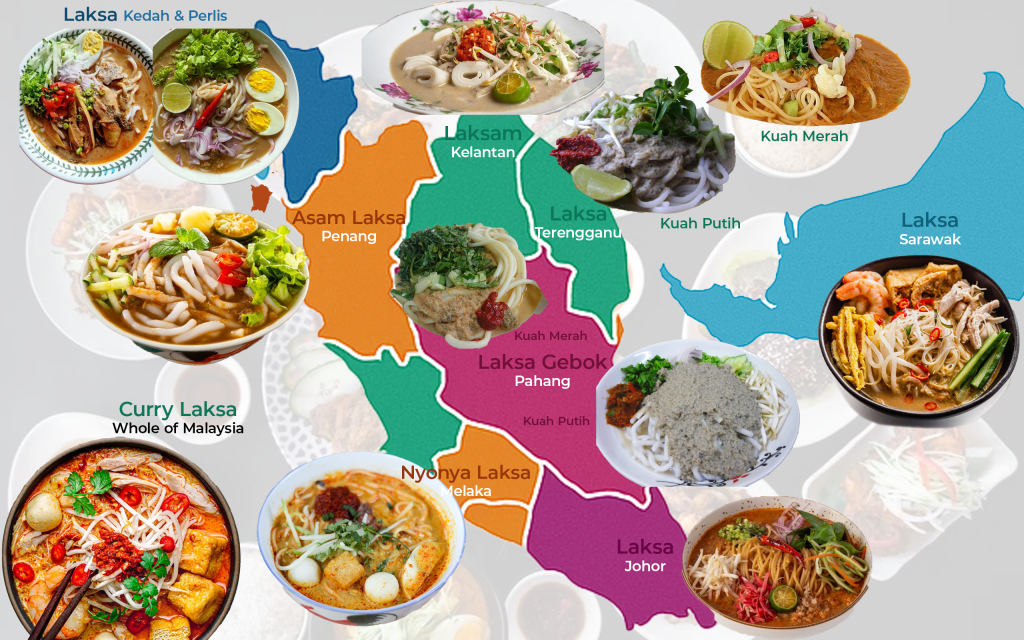
From creamy coconut broths to spicy, tangy fish-based gravies, Laksa Malaysia is a beloved noodle soup dish that has a sandy broth texture from fish/chicken/seafood. Each state has its own unique version—rooted in local culture, shaped by heritage, and proudly distinct in taste. This article maps out the rich diversity of laksa across Malaysia, from the iconic Asam Laksa Penang to Laksa Johor using spaghetti, Laksa Sarawak with its sambal-infused aroma, and even lesser-known gems like Laksa Pahang and Laksam Kelantan.
Use this Laksa Malaysia map as your culinary compass to discover how one dish can carry so many stories—and so many flavours—across one nation.

Asam Laksa
Region: Northern (Penang)
Asam Laksa Penang is one of Malaysia’s most iconic noodle dishes—bold, tangy, and packed with flavour. Unlike creamy coconut-based laksas, this version features a sour fish broth made from ikan kembung (mackerel), simmered with asam keping (dried tamarind slices), bunga kantan (torch ginger), daun kesum (Vietnamese mint), and cili kering (dried chilies). The result is a punchy, aromatic soup with layers of sour, spicy, and savoury notes.
Thick laksa rice noodles are served in the broth and topped with shredded fish, cucumber strips, pineapple, onion, red chili, mint leaves, and a spoonful of petis udang (fermented shrimp paste) for depth and umami. It’s a dish that’s unapologetically bold—fiery, fragrant, and refreshingly sour.
Often found in hawker stalls across Penang, especially in Air Itam or Balik Pulau, Asam Laksa is more than just a local favourite—it’s a cultural emblem that represents the island’s unique blend of Malay and Chinese influences. Once you’ve had your first slurp, you’ll understand why it’s consistently ranked among the world’s top noodle dishes.
Lemak Laksa / Nyonya Laksa
Region: Straits Settlement (Penang / Melaka / Singapore)
Lemak Laksa—also known as Nyonya Laksa or Curry Laksa—is a creamy, aromatic noodle dish born from the Peranakan communities of the former Straits Settlements: Penang, Melaka, and Singapore. This style of laksa reflects the fusion of Chinese and Malay culinary traditions, developed by the Straits-born Chinese (Baba Nyonya) who adapted local ingredients and spices into their cooking. The dish features santan (coconut milk), rempah (spice paste), and serai (lemongrass), creating a rich, spicy broth that’s balanced with sweet and savoury notes. It’s typically served with yellow noodles or mee hoon, topped with prawns, tofu puffs, fish cakes, cockles, and a dollop of sambal. The use of coconut milk softens the heat while enhancing the fragrance—making it a luxurious, comforting dish that carries the story of trade, migration, and cultural blending in the port cities where it first took root.
In Penang, it’s called Lemak Laksa vs in Melaka, it’s simply called Nyonya Laksa. In Singapore, Laksa Lemak is often synonymous with their version of Katong Laksa, which is creamy and less spicy.
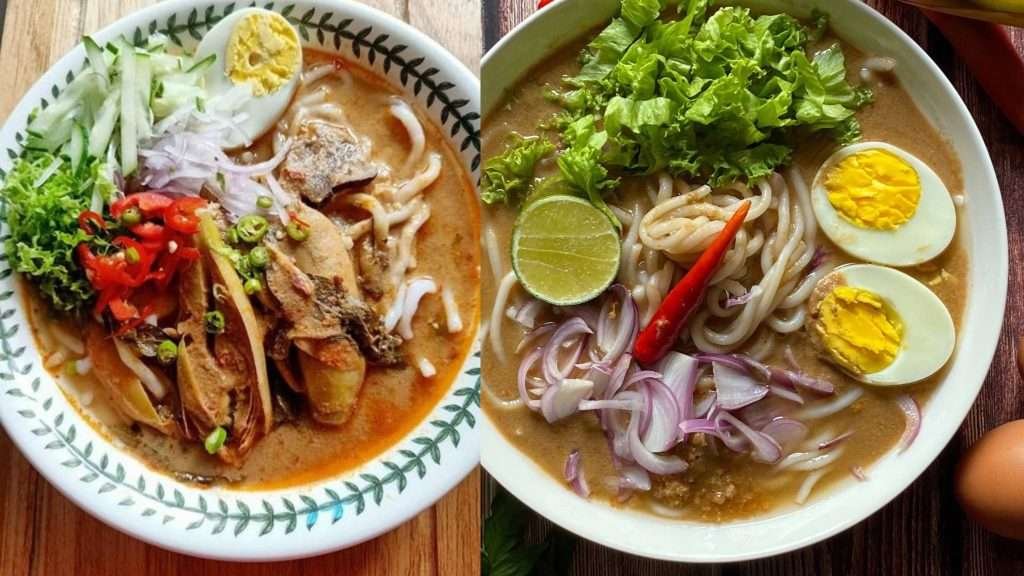
Laksa Utara
Region: Northern (Penang / Kedah)
Laksa Utara, also known as Laksa Kedah, is a northern Malaysian favourite known for its thick, bold, and spicy fish gravy. Made with ikan kembung (mackerel), bawang merah (shallots), cili kering (dried chilies), asam keping (tamarind slice), and daun kesum (Vietnamese mint), the broth is darker and richer than Penang’s asam laksa.
It’s served with thick rice noodles and topped with sliced timun (cucumber), bawang besar (red onion), telur rebus (hard boiled egg), and sambal. Hearty, rustic, and satisfying—it’s a must-try for lovers of strong, spicy flavours from the north.
Laksa Perlis
Region: Northern (Perlis)
Laksa Perlis—also known as Laksa Kuala Perlis—is a lighter, simpler take on northern laksa. The gravy is made with ikan kembung (mackerel) but is less spicy and not as thick as Laksa Kedah. Instead of being finely blended, the fish is mashed, giving the broth a more rustic, homemade texture. It’s served with thick rice noodles and topped with daun selom (water dropwort), lime, and sometimes a spoonful of sambal for added heat. Milder and refreshing, Laksa Perlis reflects the clean, honest flavours of small-town coastal living.
Laksa Kelantan (left), Photo Courtesy from Che Nom
Laksam
Region: East Coast (Kelantan)
Made with thick, rolled rice noodles (laksam) and a rich, creamy kuah putih (white gravy) based on santan (coconut milk) and blended ikan (usually mackerel). The gravy is thick, almost like lemak fish porridge. Served with ulam (raw herbs), daun kesum, bunga kantan, and sambal for added heat. Eaten with a spoon or sometimes fingers—traditional and hearty.
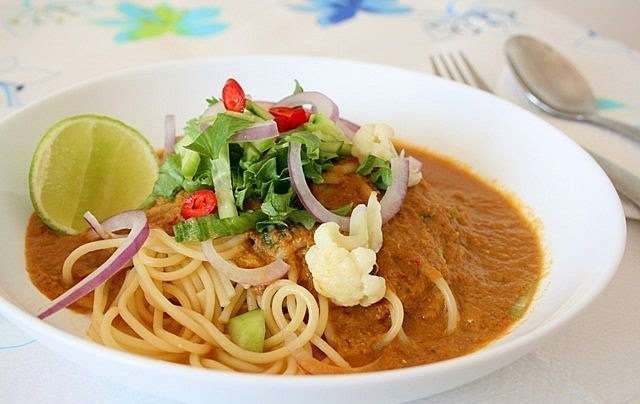
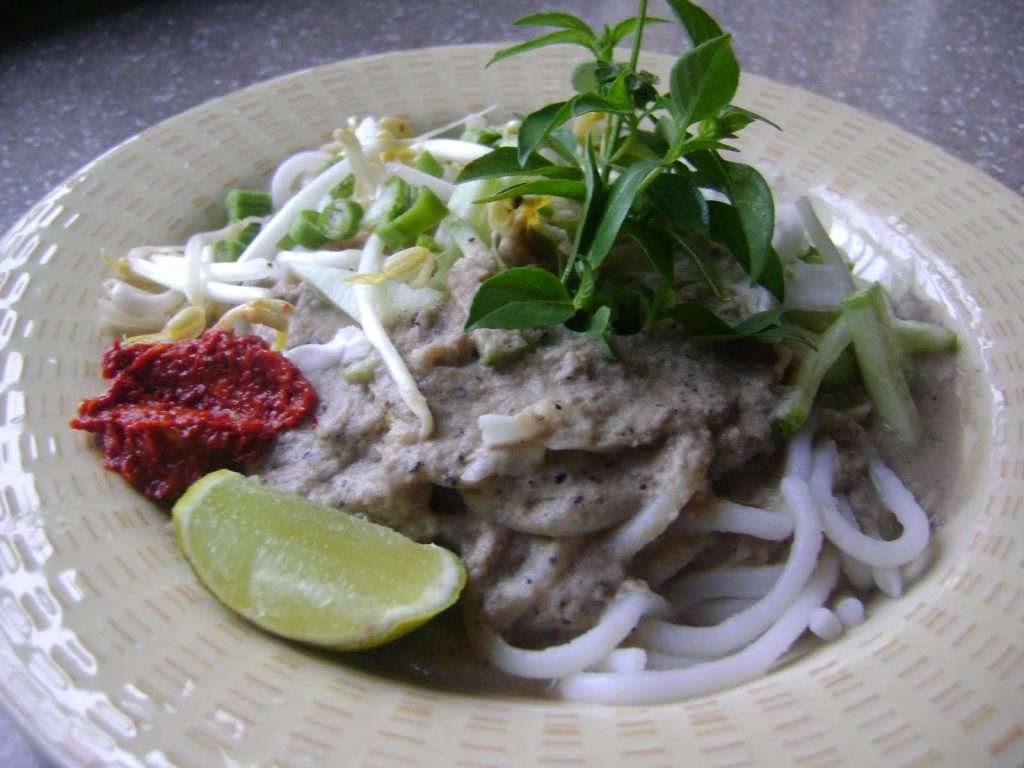
Laksa Terengganu kuah merah (left), Laksa Terengganu kuah putih (right)
Laksa Terengganu
Region: East Coast (Terengganu)
It comes in two distinct versions, each offering its own flavour profile. Whether white or red, Laksa Terengganu is light, herbaceous, and uniquely coastal—less fiery than Penang’s, but full of heart and tradition.
• Kuah Putih (White Broth)
Mild and creamy, made with ikan kembung or tenggiri, blended with santan (coconut milk), lada hitam (black pepper), halia (ginger), and bawang merah (shallots). Served with rice noodles and ulam like daun kesum, cucumber, and bean sprouts.
• Kuah Merah (Red Broth)
Richer and more aromatic. Starts with the same coconut-fish base but includes cili kisar (blended chili), kerisik (toasted coconut), belacan (shrimp paste), asam keping (tamarind slice), and palm sugar for a deeper, spicier finish.
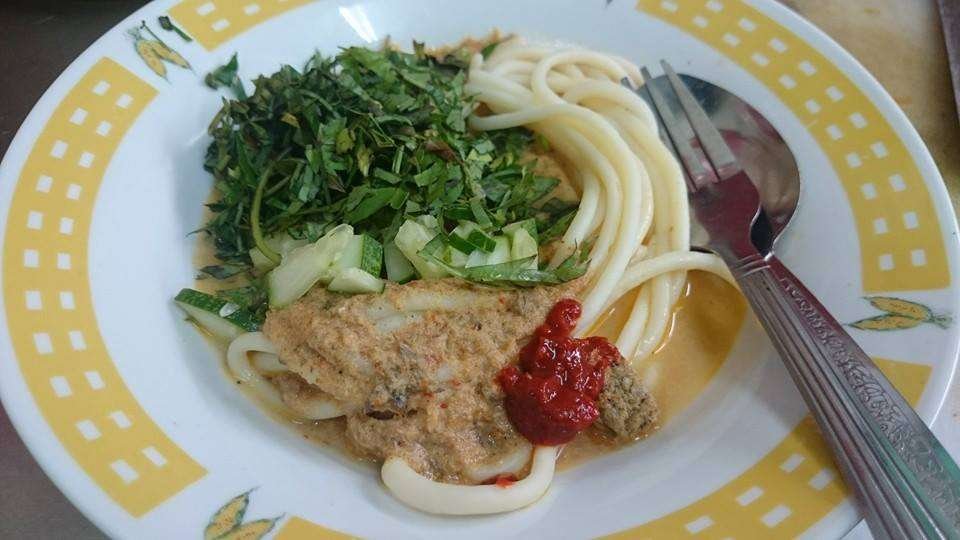
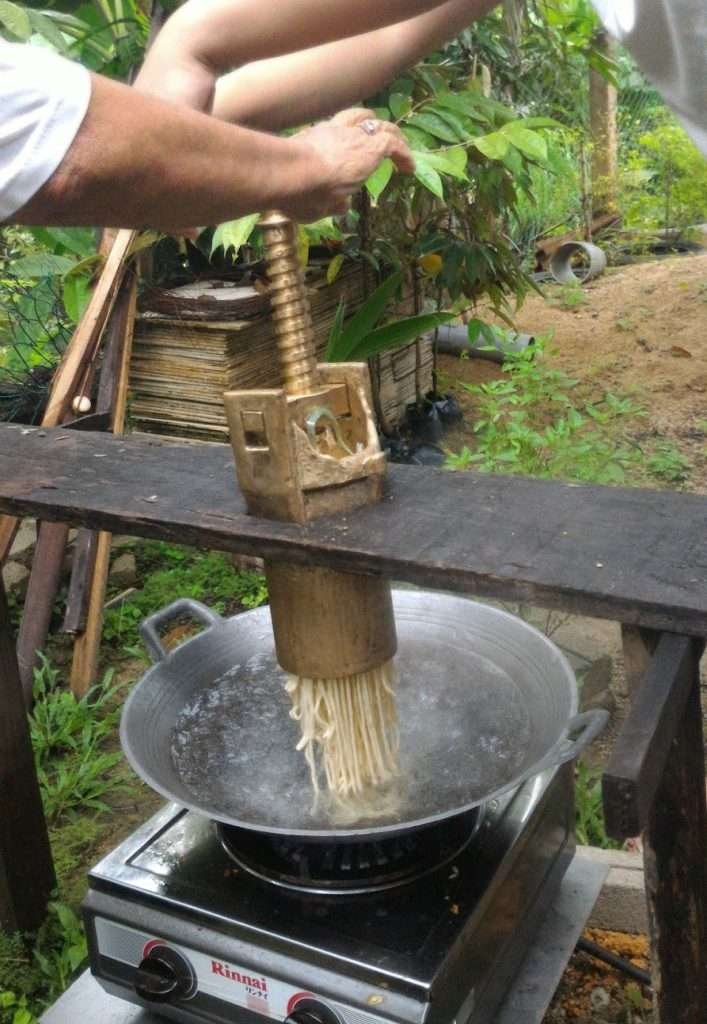
Laksa Pahang kuah merah (left), Process Making Laksa Gebok Noodle (right)
Laksa Gebok
Region: Middle (Pahang)
Laksa Gebok is a traditional Pahang-style laksa known for its hand-pressed mee gebok—thick, rustic noodles made from rice flour and shaped by hand. The laksa gravy is a spicy kuah merah (red fish curry) made with ikan selayang or kembung, santan (coconut milk), cili kering (dried chili), and aromatic herbs like daun kesum, daun kaduk and bunga kantan.
It’s often topped with telur masin (salted egg), cucumber, and herbs. Rich, spicy, and full of kampung character, Laksa Gebok is a rare Pahang treasure, often passed down through generations in home kitchens.
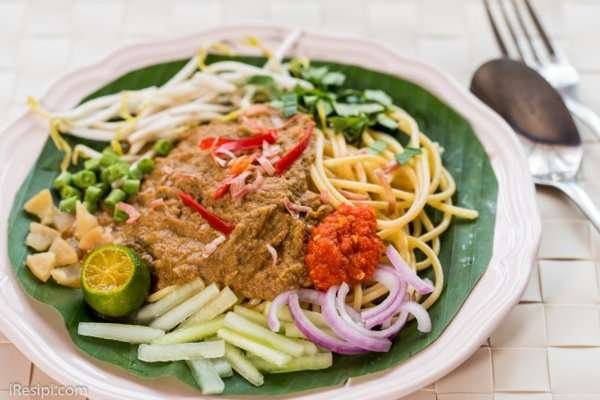
Laksa Pahang kuah merah (left), Making Laksa Gebok (middle), Laksa Johor (right)
Laksa Johor
Region: Southern (Johor)
Laksa Johor, also known as Laksa Spaghetti or Laksa Diraja is also one of Malaysia’s most unique laksas—served with spaghetti instead of rice noodles. Its thick, creamy gravy is made from ikan parang (wolf herring), santan (coconut milk), kerisik (toasted grated coconut), and rempah tumis (sautéed spice paste). Toppings include fresh ulam (raw herbs) like daun kesum (Vietnamese mint), taugeh (bean sprouts), timun (cucumber), bawang besar (red onion), and limau kasturi (calamansi lime). Traditionally eaten with hands, this royal-inspired dish is rich, aromatic, and refreshingly herbal.
Also known as “Laksa Diraja” (Royal Laksa) – informally used due to its links to Johor royalty, especially Sultan Abu Bakar, who is believed to have introduced it after visiting Europe.

Curry Laksa
Curry Laksa / Curry Mee
Region: Middle (Selangor)
Curry Laksa—also known as Laksa Kari—features yellow noodles or vermicelli in a rich, spicy coconut milk broth. The soup is fragrant with santan, serai (lemongrass), bawang (shallots), cili kisar (blended chilies), and curry spices. Common toppings include tauhu puff, telur rebus (boiled egg), bean sprouts, kerang (cockles), and ayam (chicken) or prawns. Bold, creamy, and satisfying—it’s a staple in KL and across the Klang Valley, often found at hawker stalls and kopitiams.
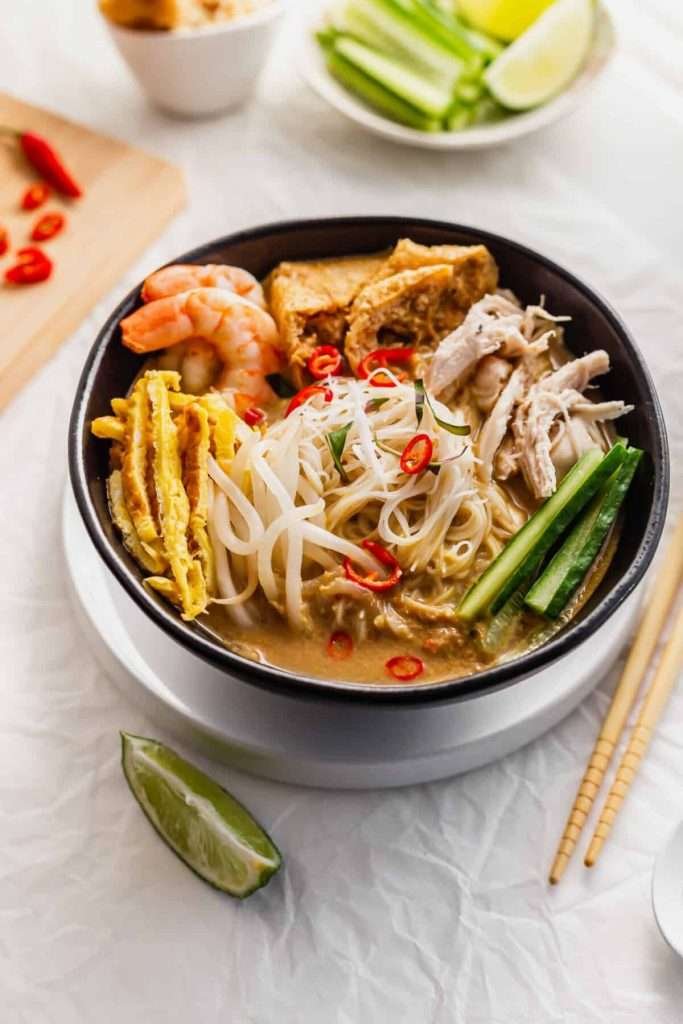
Laksa Sarawak
Laksa Sarawak
Region: Borneo (Sarawak)
Laksa Sarawak is a fragrant, mildly spicy noodle soup made with a unique paste of sambal belacan (shrimp chili paste), bunga kantan (torch ginger), lemongrass, and spices. The broth is rich but not overly creamy, made with santan (coconut milk) and chicken stock. It’s served with bihun (rice vermicelli), shredded chicken, prawns, omelette strips, bean sprouts, and a squeeze of limau kasturi (calamansi). Light yet complex, Laksa Sarawak is a proud Bornean specialty often called “breakfast of champions.”
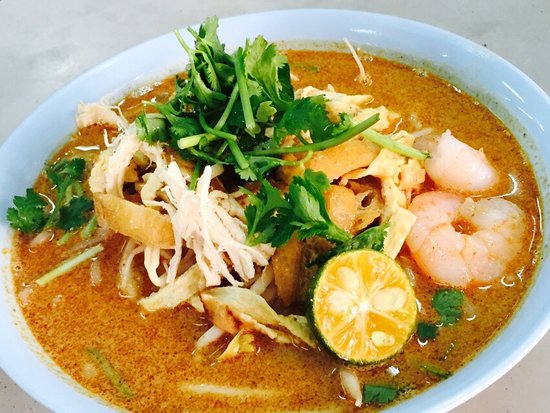
Laksa Sabah, Photo courtesy from oMalaysia
Laksa Sabah
Region: Borneo (Sabah)
Laksa Sabah is a creamy, coconut-based noodle soup influenced by both Malay and Chinese flavours. Its broth is made from santan (coconut milk), rempah (spice paste), and belacan (shrimp paste), but it’s lighter and more peppery than West Malaysian curry laksa.
Typically served with mee kuning (yellow noodles) or bihun, and topped with prawns, shredded chicken, tofu, egg, and bean sprouts. Often enjoyed as a breakfast dish in local kopitiams, Laksa Sabah is comfort in a bowl—subtle, rich, and deeply local.

